Vertigo ultimathule
Vertigo ultimathule is a species of minute, air-breathing land snail, terrestrial pulmonate gastropod molluscs or micromollusks in the family Vertiginidae, the whorl snails. [3]
| Vertigo ultimathule | |
|---|---|
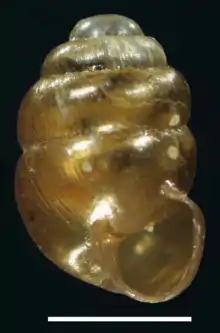 | |
| Apertural view of the shell of the holotype of Vertigo ultimathule | |
| Scientific classification | |
| Domain: | Eukaryota |
| Kingdom: | Animalia |
| Phylum: | Mollusca |
| Class: | Gastropoda |
| Subclass: | Heterobranchia |
| Order: | Stylommatophora |
| Family: | Vertiginidae |
| Subfamily: | Vertigininae |
| Genus: | Vertigo |
| Species: | V. ultimathule |
| Binomial name | |
| Vertigo ultimathule von Proschwitz, 2007[2] | |
| Synonyms | |
|
Vertigo (Boreovertigo) ultimathule von Proschwitz, 2007 alternate representation | |
Distribution
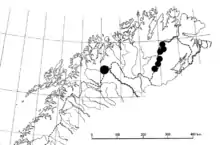
Vertigo ultimathule is found in:
- Finnmark County in the river valleys of the River Tana and its tributary Anarjohka,[4] Norway[1]
- Pältsan, the very northernmost part of Sweden,[1][4]
The type locality is Pältsan-area, in the northernmost corner of Swedish Lapland.[4]
Occurrences are to be expected in other parts of Finnmark and adjacent parts of Finland and Sweden.[4] It appears that Vertigo ultimathule is rare with a very limited distribution endemic to northernmost Norway and Sweden.[4]
Description
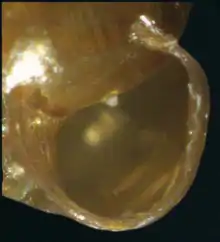
Vertigo ultimathule is a medium-sized Vertigo, which reaches a height of 2.1–2.2 mm and a diameter of 1.3–1.4 mm, the number of whorls is 4.6–4.7.[4] The shell is almost cylindrical, with marked convex whorls, which are separated by a marked, deep suture. The shape is not distinctly ovoid, as in some other Vertigo-species, and the last whorl does not narrow markedly at the base. In side view from left the outer margin of the last whorl forms a blunt angle close to the umbilicus. The aperture is completely toothless or with only a small, delicate, rather deeply set parietal denticle. The mouth-edge is simple and scarcely thickened. The colour of the shell is light yellow – dark yellow-brown. The surface is glossy, with marked, but irregular, rather coarse striation.[4]
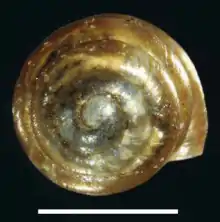 Apical view. |
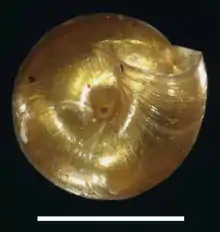 Umbilical view. |
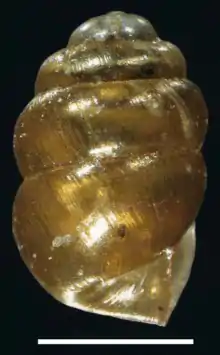 Lateral view. |
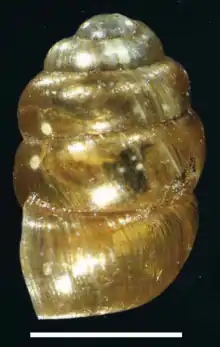 Lateral view. |
Ecology
The localities of Vertigo ultimathule are brook valleys or mountain slopes with mountain birch and often Salix shrubs. The pH of the ground litter was measured in two of the localities, the values obtained were 6.75 and 6.0.[4] The Norwegian localities are situated at 180–200 m altitude; the Swedish somewhat higher, at 520–620 m altitude.[4]
References
This article incorporates CC-BY-3.0 text from the reference[4]
- von Proschwitz T. & Neubert E. (2011). "Vertigo ultimathule". The IUCN Red List of Threatened Species. Version 2014.3. <www.iucnredlist.org>. Downloaded on 03 February 2015.
- Proschwitz T. von (2007). "Vertigo ultimathule n. sp., a new whorl-snail from northernmost Sweden (Gastropoda: Pulmonata: Vertiginidae)". Heldia 5(3): 73-74, Table 9.
- MolluscaBase eds. (2022). MolluscaBase. Vertigo ultimathule von Proschwitz, 2007. Accessed through: World Register of Marine Species at: https://www.marinespecies.org/aphia.php?p=taxdetails&id=1050733 on 2023-02-11
- von Proschwitz T. (2010). "Three land-snail species new to the Norwegian fauna: Pupilla pratensis (Clessin, 1871), Vertigo ultimathule von Proschwitz, 2007 and Balea sarsii Philippi, 1847 [= B. heydeni von Maltzan, 1881]". Fauna norvegica 30: 13-19. doi:10.5324/fn.v30i0.628
- Bank, R. A.; Neubert, E. (2017). Checklist of the land and freshwater Gastropoda of Europe. Last update: July 16th, 2017
Further reading
- von Proschwitz T. (2008). "Faunistical news from the Göteborg Natural History Museum 2007 – snails, slugs and mussels – with some notes on Vertigo ultimathule von Proschwitz – a landsnail species from northernmost Sweden new to science". Göteborgs Naturhistoriska Museum, Årstryck 2008: 51-72.
